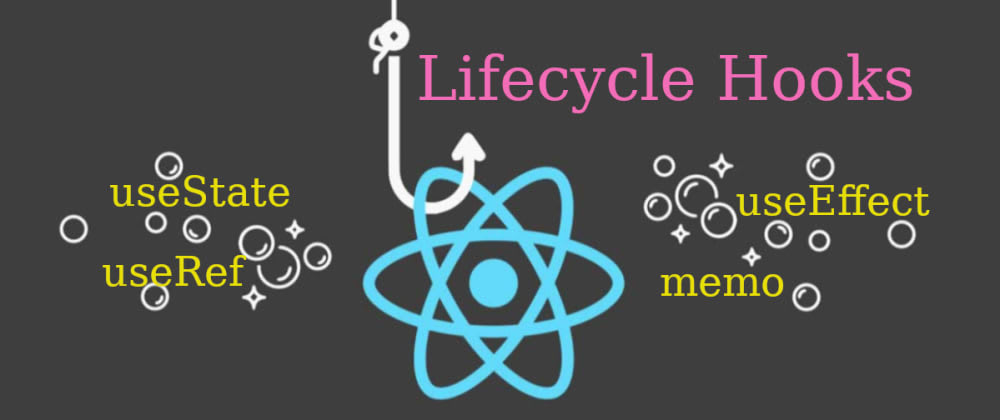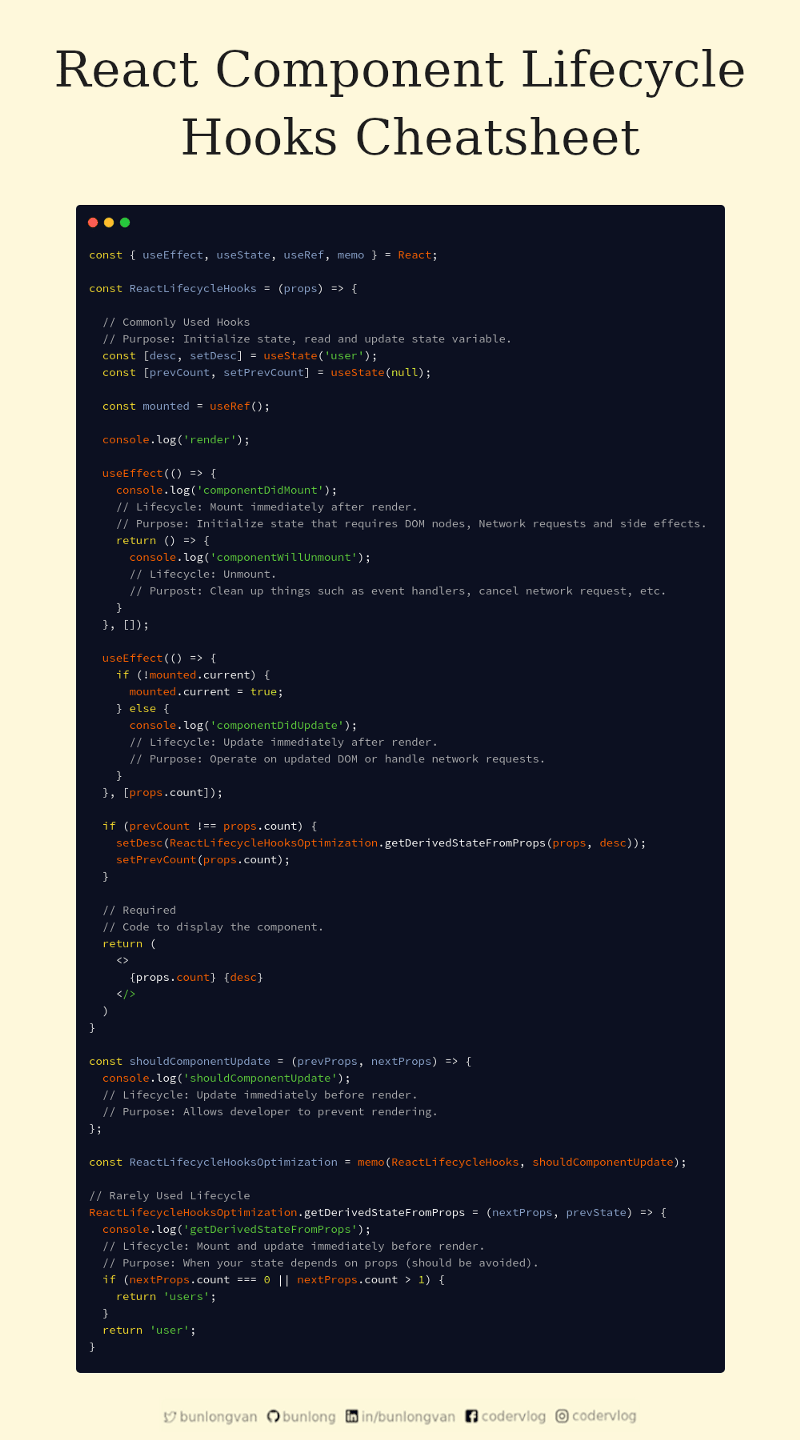
React Component Lifecycle Hooks Cheatsheet 📄
2019, Nov 27
| React Component Lifecycle Cheatsheet |
|---|
| React Component Lifecycle Methods Cheatsheet |
| React Component Lifecycle Hooks Cheatsheet |
useState, useEffect, useRef and memo are the hooks and the higher order component that allow you to replace React class component lifecycle methods.
useState
- Use: to manage a component’s local state.
- Purpose: to replace the need for
this.stateandconstructor.
useEffect
- Use: to manage side effects (Ex. an API request, tracking analytics, interacting with DOM not contained inside your React app, etc).
- Purpose: to replace the need for lifecycle methods (React Component Lifecycle Methods Cheatsheet).
useRef
- Use: to provide the way to access DOM nodes or HTML elements created in the render method.
- Purpose: to helps the
useEffectto replaces the need forcomponentDidUpdate.
memo
- Use: to manage a component’s re-rendering.
- Purpose: to replace the need for
shouldComponentUpdate.
Explanation with Words and Code
const {useEffect, useState, useRef, memo} = React;
const ReactLifecycleHooks = (props) => {
// Commonly Used Hooks
// Purpose: Initialize state, read and update state variable.
// The useState hook allows you to read and update a state variable.
// The usetState function returns an array containing the current value and the function to
// update the value.
const [desc, setDesc] = useState('user');
const [prevCount, setPrevCount] = useState(null);
// The mounted variable of useRef here is used to check the component is rendered.
const mounted = useRef();
console.log('render');
// The useEffect hook takes 2 arguments, a function containing a side effect action and an array.
// The array contains the variable(s) that you want to track.
// When a value in the array changes, the side effect function is executed.
// The empty array is passed to useEffect as its second argument
// in the purpose of replacing the useEffect with componentDidMount & componentWillUnmount.
useEffect(() => {
console.log('componentDidMount');
// Lifecycle: Mount immediately after render.
// Purpose: Initialize state that requires DOM nodes, Network requests and side effects.
return () => {
console.log('componentWillUnmount');
// Lifecycle: Unmount.
// Purpost: Clean up things such as event handlers, cancel network request, etc.
}
}, []);
// The array containing props.count is passed to useEffect as its second argument
// in the purpose of replacing the useEffect with componentDidUpdate.
// The useEffect is tracking the value of props.count, and when it sees a change, the side effect
// function is executed.
// When the side effect function executes, the logic of checking componentDidUpdate is executed.
useEffect(() => {
if (!mounted.current) {
mounted.current = true;
} else {
console.log('componentDidUpdate');
// Lifecycle: Update immediately after render.
// Purpose: Operate on updated DOM or handle network requests.
}
}, [props.count]);
// The logic of calling function getDerivedStateFromProps.
if (prevCount !== props.count) {
setDesc(ReactLifecycleHooksOptimization.getDerivedStateFromProps(props, desc));
setPrevCount(props.count);
}
// Required
// Code to display the component.
return (
<>
{props.count} {desc}
</>
)
}
// Return true if you don't want it to rerender, return false if you want it to render.
const shouldComponentUpdate = (prevProps, nextProps) => {
console.log('shouldComponentUpdate');
// Lifecycle: Update immediately before render.
// Purpose: Allows developer to prevent rendering.
return nextProps.count === prevProps.count;
};
// The memo higher order component allows you to replace the need for shouldComponentUpdate.
// The memo higher order component takes 2 arguments, a component and a comparison function of
// prevProps and nextProps.
const ReactLifecycleHooksOptimization = memo(ReactLifecycleHooks, shouldComponentUpdate);
// Rarely Used Lifecycle
// The getDerivedStateFromProps function here is created for the purpose of
// using getDerivedStateFromProps in hooks.
ReactLifecycleHooksOptimization.getDerivedStateFromProps = (nextProps, prevState) => {
console.log(`getDerivedStateFromProps
nextProps.count=${nextProps.count}
prevState=${prevState}`);
// Lifecycle: Mount and update immediately before render.
// Purpose: When your state depends on props (should be avoided).
if (nextProps.count === 0 || nextProps.count > 1) {
return 'users';
}
return 'user';
}
const Nothing = () => 'Nothing';
const App = () => {
const [component, setComponent] = useState(1);
const [count, setCount] = useState(1);
const Component = component > 0 ? ReactLifecycleHooksOptimization : Nothing;
return (
<>
<button onClick={() => (console.clear(), setComponent(component > 0 ? 0 : 1))}>Mount/Unmount</button>
<button onClick={() => (console.clear(), setCount(count + 1))}>Update value</button>
<Component count={count} />
</>
);
};
ReactDOM.render(<App />, document.getElementById('app'));
Live demo is available on CodePen.
Note
According to the React docs, getSnapshotBeforeUpdate, componentDidCatch and getDerivedStateFromError, there are no Hook equivalents for these methods yet.
References
Thanks for reading ❤
Say Hello! Twitter | Github | LinkedIn | Facebook | Instagram
Like ❤️
